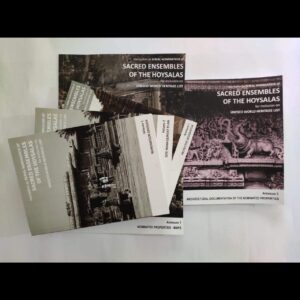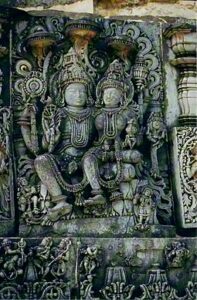The sacred ensembles of the Hoysalas, which include three temples in Karnataka, have been inscribed on UNESCO’s World Heritage List.

UNESCO recognises Karnataka's Hoysala temples as World Heritage Sites (supplied/Wikipedia)
“A dream is not that which you see while sleeping, it is something that does not let you sleep.” The late President of India, APJ Kalam’s words are perhaps true for Meera Iyer, Convenor, INTACH Bangalore, and her team, Government of Karnataka (GoK) and the Archaeological Survey of India (ASI). But only, they will all now sleep.
Why, you ask?
For the last four years, Iyer and her team, GoK and ASI, have sweat their brows to prepare the dossier for Karnataka’s Hoysala temples to be nominated at the World Heritage Convention. The results of which are grand and for the world to see.
On Monday, 18 September 2023, UNESCO recognised Karnataka’s ancient Hoysala temples of Belur, Halebid, and Somnathapura as World Heritage Sites.
🔴BREAKING!
Just inscribed on the @UNESCO #WorldHeritage List: Sacred Ensembles of the Hoysalas, #India 🇮🇳. Congratulations! 👏👏
➡️ https://t.co/69Xvi4BtYv #45WHC pic.twitter.com/Frc2IGlTkf
— UNESCO 🏛️ #Education #Sciences #Culture 🇺🇳 (@UNESCO) September 18, 2023
In a phone call with South First, Iyer’s beaming voice speaks of her sense of fulfilment, following this victory.
“We, at INTACH Bangalore, prepared the dossier for Hoysala’s nomination at the World Heritage Convention. I co-wrote the dossier. I am delirious with excitement because we have been working on this for four years. Last night, the team that worked on this got together and watched it live. There was a huge amount of cheering. It was our Chandrayaan moment!” says Iyer, sharing details of their cake-cutting moment.
The wait, of course, has paid off. Congratulatory messages have been pouring in from all quarters for Karnataka and its people.
Happy to know that Sacred Ensembles of the Hoysalas are now included in the list of UNESCO World Heritage Sites. It is a proud moment for all of us.
These heritage structures speak volumes about our rich history and people.
New addition to the list will bring more people to… https://t.co/e1H58ocynJ
— Siddaramaiah (@siddaramaiah) September 18, 2023
It’s proud moment for all Kannadigas @KarnatakaWorld. @UNESCO has just declared the Hoysala group of temples at Belur, Halebidu & Somanathpura as #WorldHeritage Sites! 🌍 Congratulations to Hon’ble @CMofKarnataka Shri @siddaramaiah & the people of Karnataka! 1/2
— HK Patil (@HKPatilINC) September 18, 2023
“This announcement is huge for the state of Karnataka. Hampi and Pattadakal were listed as World Heritage Sites in the 80s, but after that Karnataka has not had a World Heritage Site,” adds Iyer. Iyer and her team began working on the dossier in 2019 and it was submitted to UNESCO in 2022. In September 2022, an official team from the International Council on Monuments and Sites (ICOMOS) visited the site for an inspection, she adds.
“If you look at UNESCO’s official release, and PM Modi’s tweet — all of them have INTACH Bangalore Chapter’s copyrights,” she points out.
To understand how this history was made, one has to know how these monuments were shaped.

The dossier for Hoysala’s nomination (Supplied)
“One of the important things about the monument, which is not true of so many others, is that we actually know the names of those who worked on them, 900 years ago. We have the names of at least 200 sculptors and now, people around the world will read that,” details Iyer. Often, we tend to get overwhelmed by the beauty of the temples and don’t think about the makers, she adds.
The ancient site has been part of UNESCO’s Tentative list since 2014.
Historian Dr. Chikka Ranfe Gowda says, “It has taken a long time. However, it is appreciable. We are happy that at last, they have recognised our heritage and culture. Because of this, we will get some funds from UNESCO for the maintenance of these structures. More people will know about these places and tourists and foreigners will be visiting. In that way, it will help our economy also get a boost.”
Apart from the economic benefits, this will also be a great tool for education.
The problem is that most people in India think that heritage sites are a thing of the past. But it’s much more than that, adds Gowda.

A closer look at the Hoysala architecture. (Wikipedia)
“There is a lot to learn from the sculptures that are present inside these structures. You get to see the weapons they used, the vehicles, the dress code, fashion, body anatomy, and the machinery they used to sustain their livelihood. One can study what are the inventions that took place in India during this period, how wealth was generated and the contribution by the ordinary people,” he elaborates.
Then, how does one go from celebrating history to sustaining its significance with undisturbed enthusiasm? A multi-pronged strategy is required, according to Iyer.
“School curricula should definitely talk about monuments but that’s not enough. Earlier, one would have said, to encourage field trips because then they will cast their magic upon you. But today, we need to introduce technology to make the monuments come alive even if you don’t visit them in person,” she explains.
While some sections perceive tourism as a threat to the conservation of World Heritage Sites, a few others indicate that tourism is a platform to present heritage to the public and conserve it. Iyer agrees with the latter.
“Usually, one of the outcomes of a World Heritage nomination is that there is an increase in tourism. It depends on the country and state and how they promote it. I hope that the state and the people living around these monuments will benefit from this announcement. Many tourists go World Heritage Site hopping, so this should increase tourism at the domestic and international level for Karnataka,” she emphasises.

A sculpture of Vishnu with Lakshmi at Halebidu (Wikipedia)
By neglecting our temples and their architecture, we are neglecting our history, shares historian PV Nanjaraj Urs.
“I’m glad that finally, the world is recognising the Hoysala architecture. They should have done this long back. Apart from the Hoysala Utsav, we never had any program to highlight the temples and their architectural beauty. After this recognition, the government will be compelled to take extra steps to preserve them,” he remarks.
It’s not enough that we have these iconic structures.
He adds, “I won’t say that these temples were being ignored. We didn’t project it like we should have. We don’t have the marketing techniques. These days, everything depends on marketing. For a long time, apart from a few educated and interested folks, no one outside Karnataka knew of these structures. But now the world will take note. Such rare and beautiful icons from our country should be promoted. I thank all the officers who took this up and pursued the matter until now,” shares Urs.
While India and Karnataka revel in this celebratory moment, here’s hoping our historic stunners shine on.
(South First tried reaching out to the Archaeological Survey of India, but there was no response.)

May 11, 2024

May 09, 2024

May 08, 2024

May 07, 2024

May 05, 2024

May 05, 2024